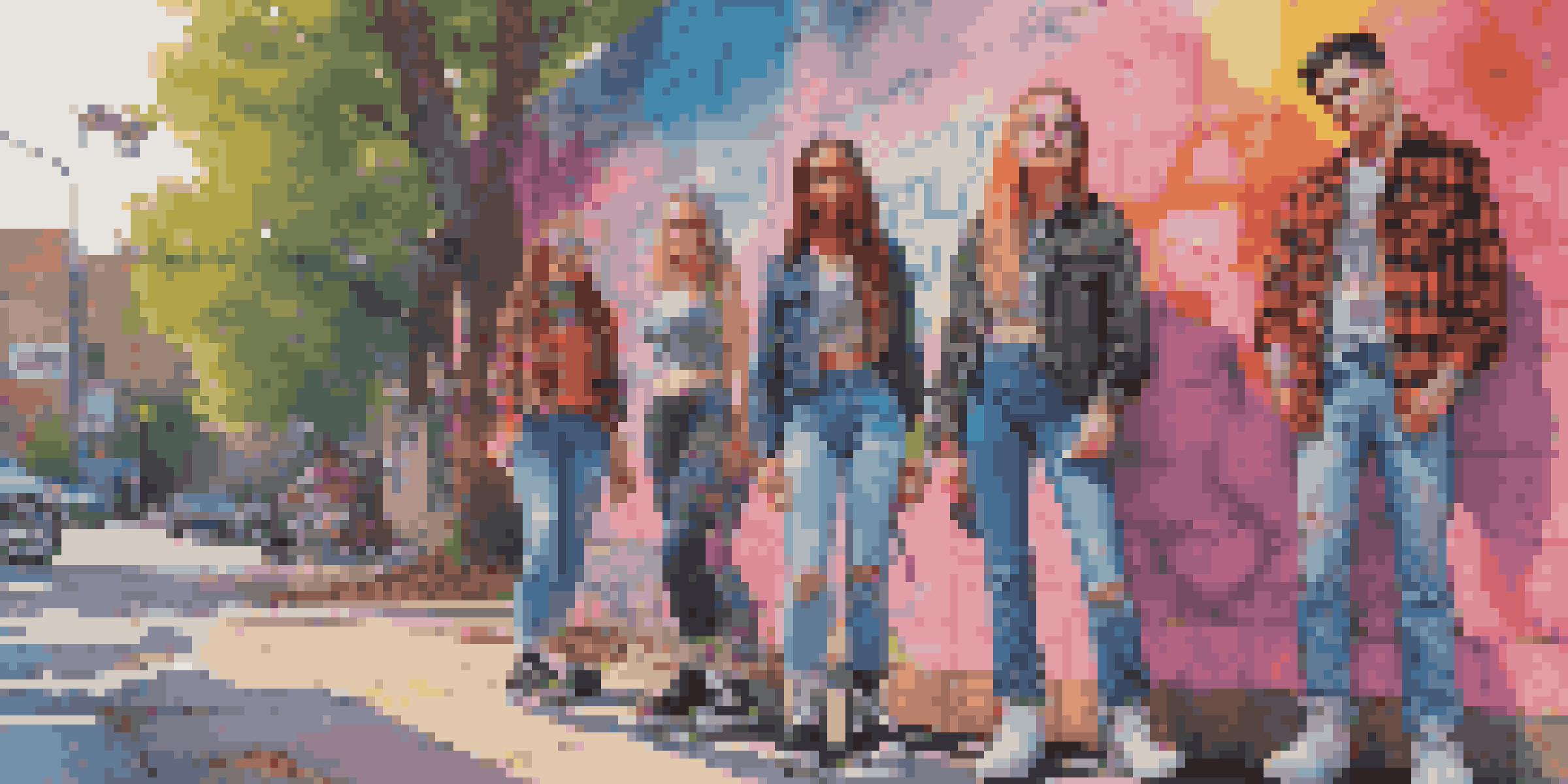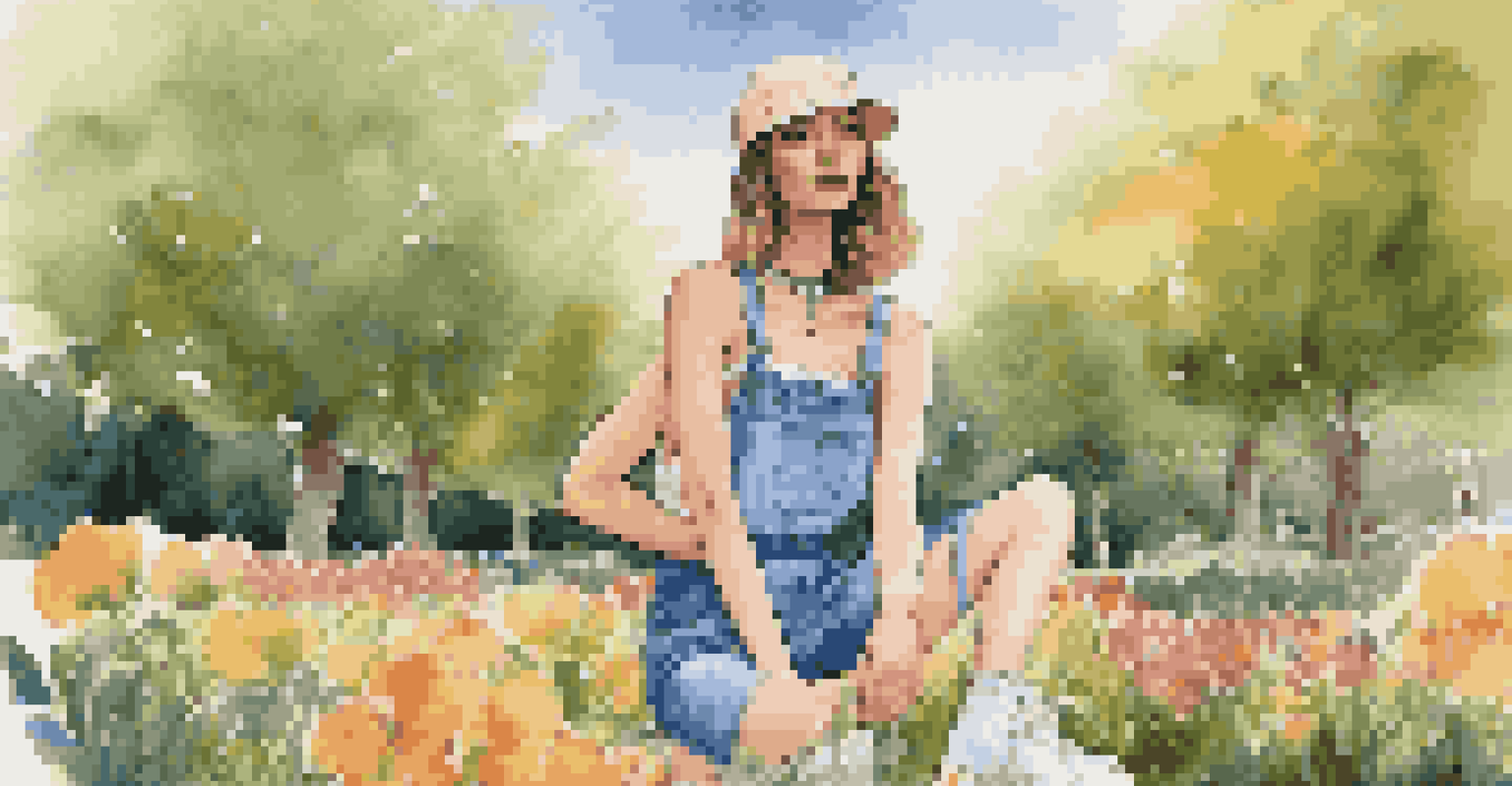Vintage Fashion Trends of the 90s: A Nostalgic Look

The Rise of Grunge: A Rebellion Against Glamour
The 90s were marked by the grunge movement, which emerged as a reaction against the polished looks of the 80s. Bands like Nirvana and Pearl Jam popularized a style characterized by flannel shirts, ripped jeans, and combat boots. This laid-back and edgy aesthetic became a symbol of youth rebellion and authenticity.
Fashion is the armor to survive the reality of everyday life.
Grunge wasn't just a fashion trend; it was a cultural statement. Young people embraced the idea of 'dressing down' and rejecting mainstream beauty standards. It was about comfort and individuality, allowing them to express their feelings and attitudes through their clothing choices.
Today, elements of grunge continue to influence modern fashion. Designers often draw inspiration from this era, blending vintage pieces with contemporary styles. The oversized silhouettes and layered looks remind us that fashion is cyclical, and what was once deemed rebellious is now celebrated.
The Bold Colors and Patterns of the 90s
If there’s one thing that defined the 90s, it was an explosion of colors and patterns. Bright neons, geometric prints, and oversized logos adorned everything from clothing to accessories. This vibrant palette was a reflection of the era's youthful energy and the rise of pop culture.

Fashion icons like Madonna and the Fresh Prince of Bel-Air showcased these eye-catching styles, making them mainstream. The trend was all about standing out and making a statement, often blending clashing colors in a fun, carefree way. It was a time when boldness in fashion was celebrated.
Grunge: A Symbol of Rebellion
The grunge movement of the 90s was a cultural statement against mainstream beauty standards, emphasizing comfort and individuality.
Today, we see a resurgence of these vibrant hues, as modern designers incorporate 90s-inspired prints into their collections. This nostalgia for bold colors allows us to relive the fun spirit of the decade, reminding us that fashion is not just about trends but also about self-expression.
The Influence of Hip-Hop on 90s Fashion
The 90s marked a significant shift in fashion, largely influenced by hip-hop culture. With artists like Tupac Shakur and Notorious B.I.G. at the forefront, baggy jeans, oversized jackets, and graphic tees became staples in streetwear. This style signified a movement that embraced comfort and individuality.
Style is a way to say who you are without having to speak.
Accessories played a crucial role, with baseball caps, chunky sneakers, and gold chains completing the look. Hip-hop fashion wasn’t just about clothing; it was a lifestyle that reflected the artists' backgrounds and the challenges they faced. This authenticity resonated with fans, making it a cultural phenomenon.
Fast forward to today, and hip-hop's influence remains strong. Many high-end designers incorporate streetwear elements into their collections, creating a fusion of luxury and casual styles. This blending of cultures showcases the lasting impact of 90s hip-hop on contemporary fashion.
The Return of Denim: From Overalls to Distressed Styles
Denim was a cornerstone of 90s fashion, with styles ranging from overalls to high-waisted jeans. Everyone seemed to have a favorite pair, and the versatility of denim made it a timeless choice for various occasions. The more distressed, the better—ripped jeans were a must-have.
Overalls, often worn with one strap down, became a playful fashion statement. They symbolized a carefree attitude and were embraced by both men and women, showing that fashion could be fun and functional. Pairing them with crop tops or graphic tees added a youthful vibe.
90s Fashion: Bold and Colorful
The vibrant colors and patterns of the 90s reflected youthful energy and self-expression, with trends that continue to inspire modern fashion.
Today, denim continues to evolve, but the essence of 90s styles remains influential. Distressed jeans are still a popular choice, reminding us that comfort and style can go hand in hand. The cyclical nature of fashion ensures that these vintage pieces will always find a way back into our wardrobes.
Accessories That Defined the 90s: Chokers and Bucket Hats
No discussion of 90s fashion is complete without mentioning the accessories that made waves during the decade. Chokers, those snug-fitting necklaces, became a quintessential part of many outfits, often paired with crop tops or band tees. This simple accessory added an edgy touch to any look.
Bucket hats also saw a significant rise in popularity, often worn by celebrities and influencers alike. These hats were not just functional but also a fashion statement, representing the playful and laid-back vibe of the 90s. They often featured bright patterns or logos, making them a fun addition to any ensemble.
Even today, chokers and bucket hats are making a comeback, proving that good style never truly goes out of fashion. Modern interpretations of these accessories allow us to pay homage to the 90s while keeping our looks fresh and trendy.
The Iconic Styles of 90s Supermodels
The 90s were a golden age for supermodels, with names like Naomi Campbell, Kate Moss, and Cindy Crawford gracing runways and magazine covers. Their unique styles and striking looks defined an era, influencing not just fashion but also beauty standards worldwide. The models often showcased a blend of high fashion and casual wear, making them relatable yet aspirational.
These supermodels popularized key trends such as slip dresses, oversized blazers, and minimalistic styles. The '90s supermodel look was all about effortless beauty, often highlighted by natural makeup and simple hairstyles. This shift towards a more laid-back aesthetic marked a significant change in the fashion industry.
Fast Fashion's Impact Begins
The rise of fast fashion in the 90s made trendy clothing accessible, but also sparked important discussions about sustainability and ethical practices.
Today, the impact of 90s supermodels can still be seen in the fashion world. Their ability to effortlessly mix high and low fashion continues to inspire modern icons, reminding us that style is about confidence and individuality.
The 90s and the Rise of Fast Fashion
The 90s marked the beginning of the fast fashion phenomenon, with brands like H&M and Zara making trendy clothes accessible to the masses. This shift changed the way consumers approached fashion, allowing them to frequently update their wardrobes without breaking the bank. It was a time when style became synonymous with affordability.
While fast fashion provided variety, it also sparked conversations about sustainability and ethical production. The rapid production cycles led to concerns about environmental impacts and labor practices, prompting many to rethink their shopping habits. This awareness is gradually reshaping the fashion landscape today.

As we navigate the modern fashion world, the lessons from the 90s serve as a reminder of the importance of conscious consumerism. Balancing trendiness with sustainability is now a priority for many, ensuring that the legacy of 90s fashion continues to evolve positively.